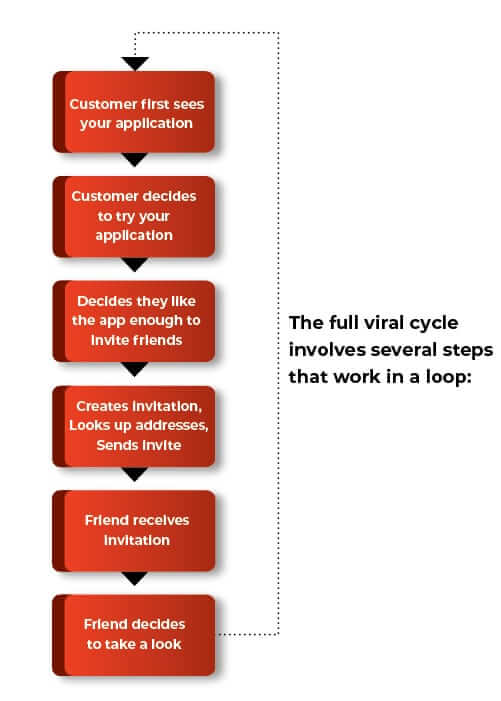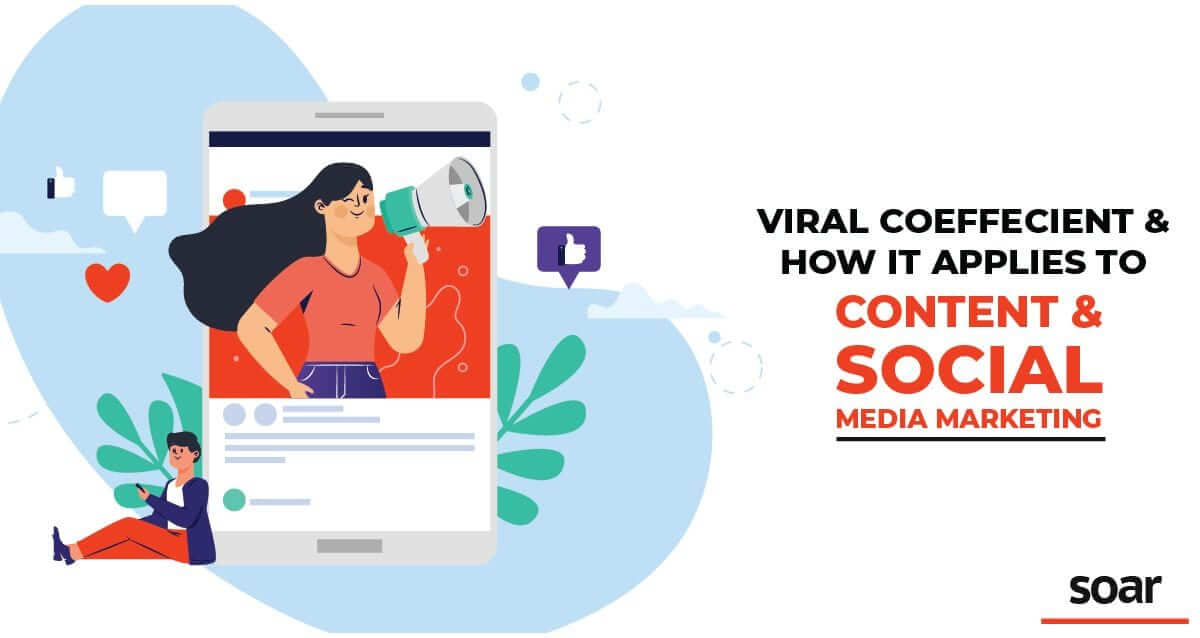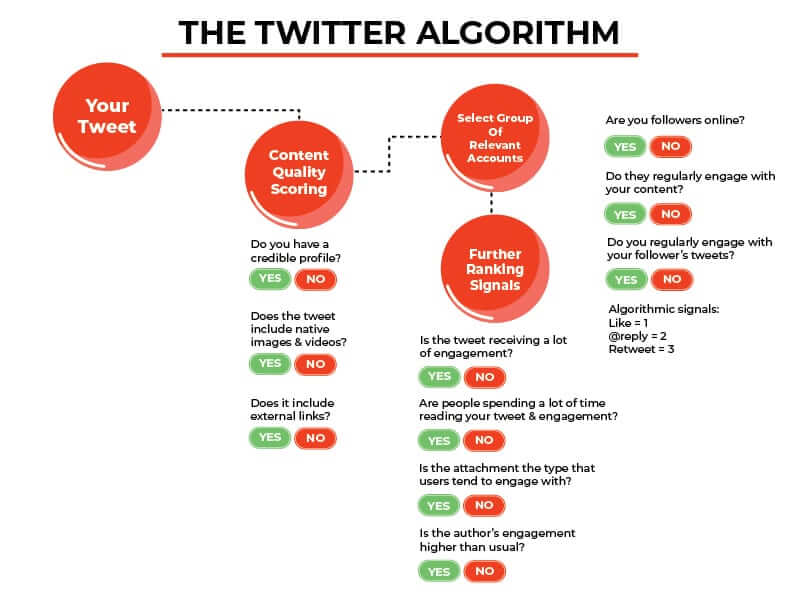What is Viral Coefficient?
Viral Coefficient is the numerical value of the number of new customers acquired by a business through the means of existing satisfied customers. Though there are many methods to promote your business like using Google AdWords, SEO optimization and other social media marketing skills, the virality coefficient stands out from the rest. This is because, with every other form of promotion, you’re advertising your brand through one medium or the other. As opposed to this virality coefficient is a method where a customer is promoting your business on your behalf. The authenticity and trust that this establishes outpower any paid advertisement in terms of genuineness.
Why does it work?
Since this method focuses on getting more and more people to engage with your content and motivate them to share your business with their friends further, this method works effectively if done correctly.
It allows the new potential customers to be eased and relaxed about experimenting with your brand as the source of that information is one of their relative or friend whom they trust.
People generally see ads with scepticism, however not what their close friends have to say. Virality Coefficient works by taking advantage of this personal relationship to promote your product or service without actually promoting it.
How does it work?

The calculation of virality coefficient –
1. Assume your current audience/users strength is 100.
2. Suppose each of your users sends out 10 invitations to their friends and family that sums up to 1000. (10×100)
3. Now find out the percentage of new converted users through the invitations of your existing users. Let’s assume the percentage is 15%.
4.15 per cent of 1000, is 150. You now have 150 new users.
5. Hence your total customers are now (150+100) 250 users.
6. Therefore to calculate your virality coefficient divide your newly acquired customers/ existing customers. 250/100, which is 2.5.
This is considered a good virality coefficient. For any business to have successful viral growth, the Coefficient needs to be greater than 1. 2.5 is a considerably excellent margin which might not be the case always, however, anything above 1 is considered safe.
Misconceptions about virality coefficient –
1. Taking into consideration the existing customers for each cycle: right or wrong?
There is an ongoing debate amongst many users of virality coefficient if the calculation should include the existing customers for each cycle of calculation or not.
To be honest and practical, it doesn’t make sense to keep adding the newly added members of cycle 1 to the existing customer base and then taking the total of that as a base for the second cycle.
Chances are if your customer has promoted your service once if the first stage, he won’t repeatedly keep promoting it through each cycle.
Hence whenever you’re calculating for round 2 or 3 keep the previous round’s newly acquired customers as a base or existing customers and not the entire population.

2. What should be the yardstick: number of invites vs acquisition –
This is very important to understand. Many times brands feel like they’ve mastered the viral Coefficient when their existing customers keep sharing their content to their friends and colleagues in huge numbers.
However, this is not the case. If you are a brand whose existing customer base is 100, and each of your customers shares your content with 15 of his friends, that’s not a milestone to celebrate.
If none of those 15 potential customers/per existing customers converts, then, your viral Coefficient will be 0. As a result, this would leave your brand with the same number of members it had when you started.
Hence always measure success by Acquisition of customers.
Types of virality coefficient –
1. Word of mouth.
The most obvious and traditional method of gaining the virality coefficient is by word of mouth. The existing customer base talks and discusses your products verbally to their relatives and friends as they are satisfied with your products or services.
It is also when some service or product gets so famous that people start using it as an adjective. For instance, instead of saying search the net, many people say Google it.
2. Outbreak virality
This happens when the product or service has a certain characteristic or element that makes it addictive or viral among the users who experience using the product.
There’s a sudden growth in its popularity, and hence more and more people quickly try to be a part of this trend. An excellent example of this is the mobile game that went viral named Flappy Birds.
3. Infectious virality
Such virality is achieved when people that use a product start inviting others to use the product. This is because the product is known for its networking capabilities.
As more people join the product/service, more value the software can provide to the existing customers as it requires more interactions to utilize its potential truly.
An excellent example of this can be iMessage which is a dedicated messaging app for the iPhone that other android devices can’t use. Hence if there’s an individual who purchases an iPhone, he or she will try to convince their friends to buy an iPhone to use the services of iMessage.
4. Incentive virality
Any sort of virality promotion scheme where the customers who promote the services or products of a brand are given incentives to do so. Incentives could be anything ranging from discounts, money, storage space, extended membership and much more.
Usually, both the existing customer who refers and the new customer that registers themselves with the brand are benefited. This increases the chance of more successful conversion as the customers get value for subscribing or promoting the brand.
5. Pull virality
Pull Virality is when customers make use of social media. The existing customers spread information about the brand to their networks using their social media platforms.
Most of the social media platforms are linked for allows cross-platform sharing options which help any content reach more audience as it’s being shown to an audience of two platforms.
For instance, Instagram is an excellent example of this as it allows people to share their posts and stories to Facebook, Twitter and some other social media apps.
Virality coefficient and its relevance with content and social media marketing –
Social Media Marketing is the new age’s answer to all the marketing needs and strategies. It allows brands to reach out to an enormous number of potential customers for a very minimal fee.
There are various social media marketing techniques that almost all brands have been using these days. Methods for social media marketing includes using Google Adwords, SEO optimization, Content optimization, PPC campaigns and much more.
Note that, all of these methods require some sort of investment to make your post more visible to a broader audience. However, when you talk about Virality Coefficient, it talks about putting such content forth that markets itself by allowing people to find the content so engaging that they share it to their friends and family.
This also reduces the cost of promotion significantly and also increases the authenticity of the brand to the new potential customers as a source of information is reliable and known.
There are a few aspects you could keep in mind to ensure that your post is shareable across various social media platforms
1. Concrete –
When you’re writing content for web, you need to carefully select topics that aren’t too generic or too theoretical. Such content would either be too saturated with the competition or too difficult for potential customers to comprehend. Create a concrete, reliable material.
2. Simple –
Chose a topic that is easy to understand, however, this doesn’t necessarily mean to stick to annoying issues. It is more on the lines of identifying the focus area of your content and focusing on how easily can your audience grasp the main focus area on the first glance of the material.
3. Unexpected –
One prerequisite to go viral is adding value to the customer in any way possible. If you share well-read and well-known content, that doesn’t provide any additional value to your reader, they will not find it worth sharing with their peers as it doesn’t offer any new developments or insight on the topic.
Hence you should always look for fresh perspectives or an element of surprise that catches their attention.
4. Emotional Stories –
Emotional stories don’t always have to mean emotions of love, guilt or sadness. The main idea is that your concept or content should evoke certain emotions in your audience that makes them more attached to the content you’re presenting.
This ensures that they are invested in what you have to say. Also that it is in alignment with how they feel. If you get this right, the viewer will definitely share your content further and make it viral.
5. Credible –
Your content can be entertaining, engaging and worth sharing. However, if your content isn’t credible, it raises a question on its genuineness and then your brand’s overall authenticity.
This could have an adverse reaction on your brand as people would see you in a negative light and hence, instead of sharing your content, they might unsubscribe to your services themselves.
Therefore always make sure that your content is accurate and backed up by credible sources.
Best social media platforms for virality coefficient-
1. Reddit
Reddit is one of the largest community platforms. It has threads and communities for almost all possible topics however the functionality of Reddit is not fully understood by many people.
People know how to consume the data available there but not how to promote their own data efficiently. Hence this makes Reddit a great platform to go viral on.
Since Reddit creates a link for your subreddit, sharing your thread and communities becomes much easier for your existing customers. There are numerous ways people can engage with your content too. Moreover, they are allowed to upvote or downvote your thread or each individual answer.
There are stats of followers, responses and answer follow data points. As a result, if you score well on all such aspects, your content will go viral very quickly.
An insight –
- 26.4 million users use Reddit each month
- There are 330 million active users on the platform per month globally.
2. LinkedIn
LinkedIn is a community of professionals seeking news and information regarding business, industry, trends and other such factors. There is a pool of professionals who can be potential clients and potential customers too.
LinkedIn is a very active platform where effective and relevant content goes viral very quickly. Hence it is an ideal platform to make your content go viral by implementing good viral coefficient practices.
An insight –
- 75 per cent of LinkedIn users have salaries above $50,000.
- 106 million users (approx) login and engage with content on LinkedIn each month.
- 76 per cent of LinkedIn users depend on the recommendations of people from their professional network.
3. Twitter
Twitter is the perfect platform for sharing information and talk about what’s trending. Moreover, the unique feature that makes twitter preferred by customers over other platforms is its 280 character limit.
Since you can’t post more than the given limit, chances of people spamming reduce. You could get quickly viral your content that has the potential to be a newsworthy headline on Twitter. Moreover, the option to retweet moreover helps increase the virality of your post.
The Twitter algorithm –

An insight –
- 74 per cent of users take help of their network for getting their news and updates.
- 330 million active users on Twitter per month.
- 11 per cent of Americans rely on Twitter to stay updated with news.
- 330 million active users on Twitter per month.
In this post, you’ve learned –
What is Virality Coefficient?
Why is Virality Coefficient important.
Misconceptions regarding Virality Coefficient.
Virality Coefficient and its relevance to content and social media marketing.